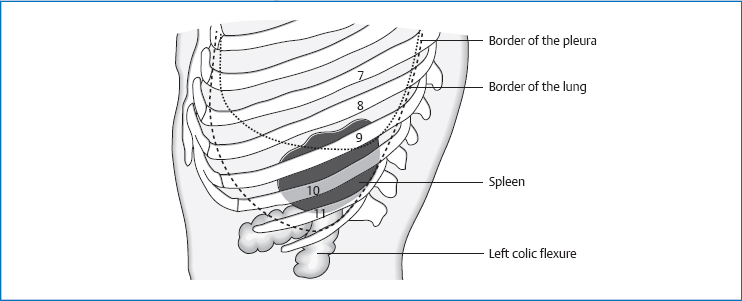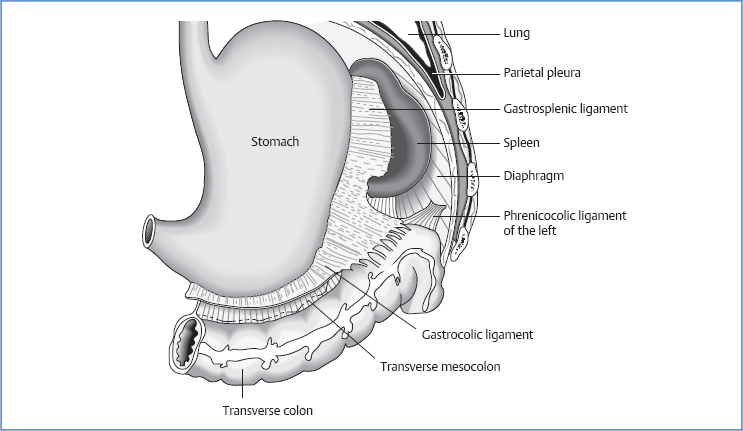9 The Spleen The spleen is located intraperitoneally in the hypochondrium on the left side, at the height of ribs 9–11. Its longitudinal axis runs approximately by rib 10 from top to bottom, from back to front, and from outside to inside. The splenic bed is bordered caudally by the phrenicocolic ligament on the left. Splenic artery (via the splenorenal ligament). Splenic vein (via the splenorenal ligament). Pancreaticolienal lymph nodes with connection to celiac, hepatic, and gastric lymph ducts. Fig. 9.1 Location of the spleen at the height of ribs 9-11. Fig. 9.2 Attachments of the spleen. Maximal time: 9–11 a.m. Minimal time: 9–11 p.m. For basic information, see page 34. Mobility The spleen follows the movements of the diaphragm: during inhalation, we see a shift in a caudal-medial direction; during exhalation it is in the opposite direction. The spleen’s position is also affected by shifts in body posture and changes in the tension and length of the phrenicocolic ligament on the left and the transverse colon. A full stomach similarly displaces the spleen anteroinferiorly. Definition. This term refers to an enlarged spleen. The increase in size can be so great that the spleen becomes palpable. Causes. Splenomegaly is a possible symptom in different pathologies, such as: Clinical. The spleen is palpable or diagnosable by technical means because it is enlarged. In cases where the enlargement of the spleen is gradual, symptoms arise as a result of the displacement. In cases with a more rapid enlargement, we can see coliclike pain in the left upper abdomen radiating into the left shoulder. As splenomegaly is often a secondary symptom, we must pay attention to other signs of disease. Definition. The occurrence of anemia, granulocytopenia, or thrombocytopenia as the result of splenic hyperfunction. This hyperfunction frequently occurs together with a splenomegaly. Causes. See page 89 (splenomegaly). Clinical. See page 89 (splenomegaly). Changes in the blood count.
Anatomy
General Facts
 Size: 10–12cm long, 6–7cm wide, 3–4cm thick (about fist sized)
Size: 10–12cm long, 6–7cm wide, 3–4cm thick (about fist sized)
 The spleen weighs 150–200g.
The spleen weighs 150–200g.
 In its normal size, it is not palpable.
In its normal size, it is not palpable.
Location
Topographic Relationships
 diaphragm
diaphragm
 stomach
stomach
 left kidney and adrenal gland
left kidney and adrenal gland
 transverse colon
transverse colon
 phrenicocolic ligament on the left (= sustentaculum lienis)
phrenicocolic ligament on the left (= sustentaculum lienis)
 pancreas
pancreas
 ribs 9–11 on the left
ribs 9–11 on the left
Attachments/Suspensions
 organ pressure
organ pressure
 turgor
turgor
 phrenicocolic ligament on the left
phrenicocolic ligament on the left
 gastrosplenic ligament
gastrosplenic ligament
 splenorenal ligament (previously phrenicolienal ligament)
splenorenal ligament (previously phrenicolienal ligament)
 pancreaticosplenic ligament
pancreaticosplenic ligament
Circulation
Arterial
Venous
Lymph Drainage


Innervation
 sympathetic nervous system from T5 to T9 via the major splanchnic nerve and switching in the celiac plexus
sympathetic nervous system from T5 to T9 via the major splanchnic nerve and switching in the celiac plexus
 vagus nerve
vagus nerve
Organ Clock
Organ-Tooth Interrelationship
Movement Physiology according to Barral
Physiology
 removal of old or damaged blood cells (especially erythrocytes), thrombocytes, microorganisms, or immune complexes
removal of old or damaged blood cells (especially erythrocytes), thrombocytes, microorganisms, or immune complexes
 antigen-induced differentiation and proliferation of B and T lymphocytes
antigen-induced differentiation and proliferation of B and T lymphocytes
 storage of thrombocytes and erythrocytes
storage of thrombocytes and erythrocytes
Pathologies
Symptoms that Require Medical Clarification
Splenomegaly
 blood and lymph diseases (lymphoma, leukemia, hemolytic anemia)
blood and lymph diseases (lymphoma, leukemia, hemolytic anemia)
 liver diseases (cirrhosis, hepatitis)
liver diseases (cirrhosis, hepatitis)
 rheumatic disorders
rheumatic disorders
 storage disorders (e.g., amyloidosis)
storage disorders (e.g., amyloidosis)
 infectious diseases (e.g., malaria, typhoid)
infectious diseases (e.g., malaria, typhoid)
 sarcoma
sarcoma
 abscess
abscess
 echinococcal cyst
echinococcal cyst
Hypersplenism
Osteopathic Practice
Cardinal Symptom
Stay updated, free articles. Join our Telegram channel

Full access? Get Clinical Tree





